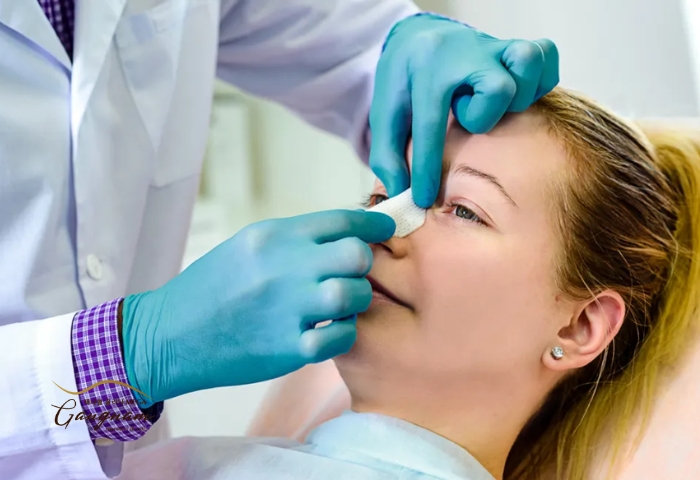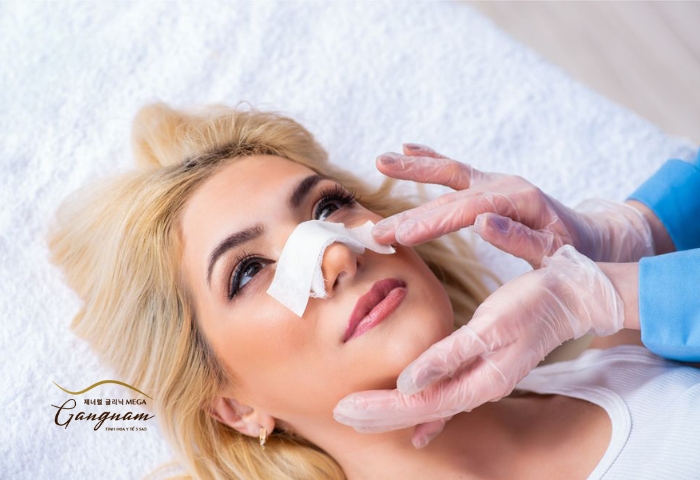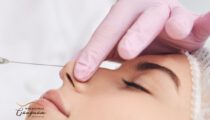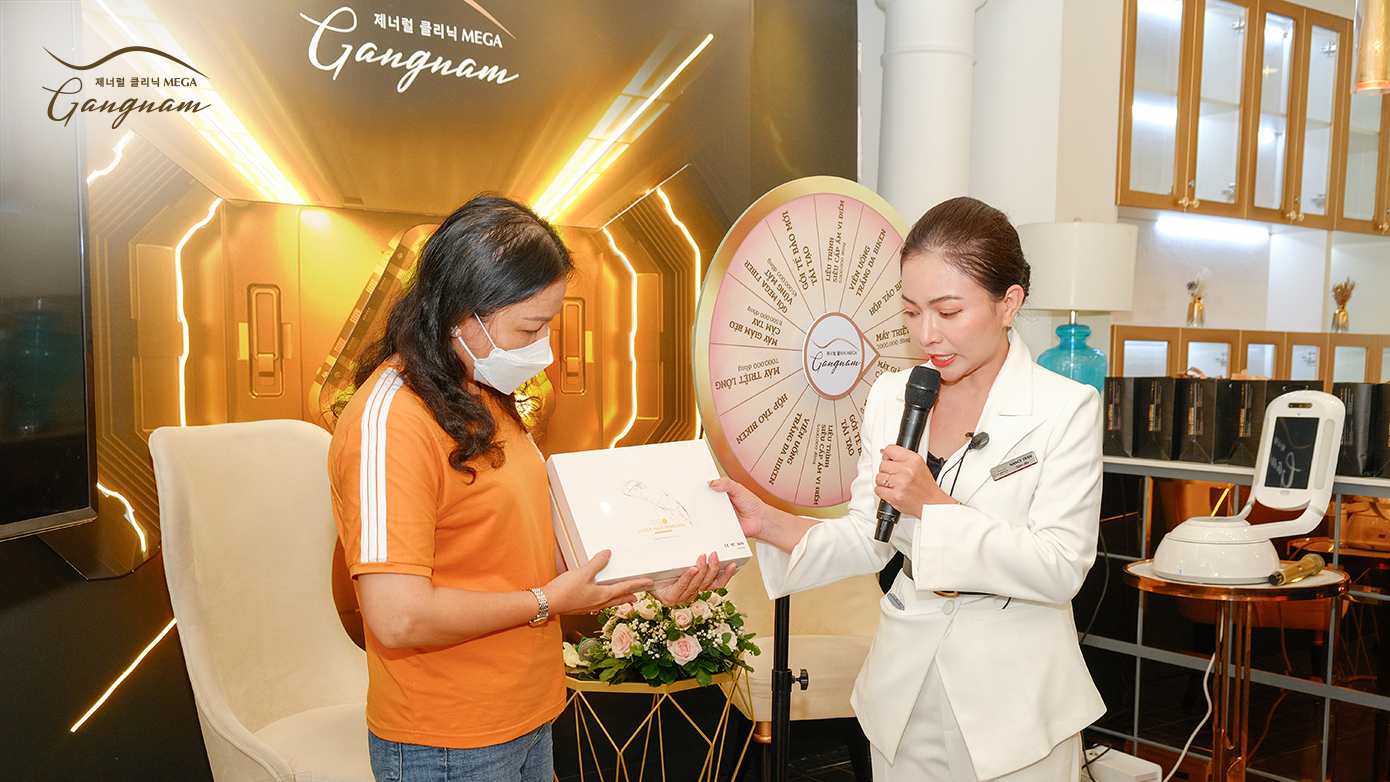Cosmetic experience: how many days after rhinoplasty surgery to remove splint?
Rhinoplasty surgery is a complex process and has a fairly deep level of intervention. So after the procedure, doctors often use devices to fix the nose shape, such as a nose shaping splint. For those of you who have done this method, you will probably wonder how many days it takes to remove the splint after rhinoplasty surgery. Follow this article now to get the most complete and detailed answer!

Doctor explains details about rhinoplasty, how many days does it take to remove splint?
Why do people often use splints after rhinoplasty?
Rhinoplasty surgery has a long history of development and has existed for many centuries. Initially, this process was performed to treat injuries and some diseases of the nose. However, over time, this surgical method has developed into a cosmetic process, performed with the aim of improving the shape of the nose according to people’s wishes.
After rhinoplasty, a fixed splint will be used by the surgeon to maintain the new shape and position of the nose. So why is a nose splint necessary in rhinoplasty surgery and how does it help improve the final result?
- Shape your nose as desired: One of the main reasons to use a nose splint in rhinoplasty surgery is to maintain shape. When the doctor corrects the nose structure by removing or changing bone and soft tissue, the nose can easily return to its original position or not mold without external support. The splint will hold the nose in its new position, helping it adapt to the new shape and position the doctor has created. The splint helps stabilize surgical results and prevent external forces by reshaping the nose during recovery.
- Control excessive swelling: In addition to maintaining shape, nose splints also help control signs of swelling in the nose area after surgery. An important part of the recovery process after rhinoplasty is reducing swelling because if the nose swells too much or goes on for too long, it can affect the final result. A nose splint keeps the nose stable and helps minimize swelling, allowing for better recovery.
- Supports improvement of respiratory function: In addition, nose splints can also help regulate respiratory function. In some cases, rhinoplasty involves not only changing the shape but also improving the patient’s respiratory function. Nose splints can be used to make the nose flatter, expand the nasal cavity, or adjust other factors to improve air flow into the nose and throat.
Answer: How many days after rhinoplasty to remove splint?
The time to remove the nose splint after rhinoplasty can vary depending on each case and the complexity of the surgery. However, in most cases after treatment, the nose splint will be kept in place for a period of one week to two weeks. However, the final decision on when to remove the splint will be made by your surgeon. Based on the specific condition of the nose and the body’s signs of recovery.

The time to remove the splint after rhinoplasty can be from 1-4 weeks, depending on the specific condition
Here are some important factors that can affect when to remove the nose splint:
Type of nose splint: There are two main types of nose splints after rhinoplasty surgery: internal nose splints and external nose splints. Internal nose splints are usually kept in place for shorter periods of time, mostly one to two weeks. Meanwhile, with an external nose splint, it may take longer, from two to three weeks or even a month.
Swelling: You need to be examined regularly, as required, so that the doctor can monitor swelling and the ability to heal scars in the nose area. When the swelling subsides and the wound has healed enough, the splint can be removed without negatively affecting the final result. The splint will be removed to allow the nose to recover faster.
Respiratory function: If your rhinoplasty surgery involves improving respiratory function. The doctor can wait until the nose is stable and breathing is not affected before deciding to remove the splint.
Natural healing ability: Another important factor to keep in mind is our own feelings. Using a nose splint for too long can cause inconvenience and loss of sensation in the nose. Therefore, you need to inform your doctor about this information to make a decision to remove the splint at the appropriate time.
Recovery time after rhinoplasty surgery can vary and directly affects the decision on how long it takes to remove the nose splint. You need to follow your doctor’s instructions and have regular check-ups so they can assess your actual condition and decide the appropriate time to remove the splint.
How is the nose splint removal procedure performed?
The nose splint removal process is an important part of the recovery process after rhinoplasty surgery. Nose splint removal is usually performed by a rhinoplasty specialist or an ORL (Ear, Nose, Throat) specialist and includes the following specific steps:

Information about the process of removing the nose splint after surgery
Prepare:
Before removing the splint, your doctor will make sure you are stable enough after rhinoplasty. This requires that your nose is significantly less swollen and the wound has healed enough to cause no problems when the splint is removed.
Endoscopic examination:
In some cases, the doctor may use an endoscope to more closely examine the structures inside the nose. This may be done to ensure that there are no problems inside the nose that require further treatment before the splint is removed.
Removing the nose splint:
Your doctor will use small surgical tools to carefully and safely remove the nose splint. This process is usually painless and only takes a short amount of time.
Check the result:
After the splint has been removed, the doctor will check the final results of the rhinoplasty surgery. If necessary, they can make minor adjustments to ensure the nose achieves the desired shape and position.
Clean your nose:
After removing the splint, your doctor will clean your nose and apply any necessary anti-infective medications or lotions. They may also place a bandage on the nose if necessary to protect the nose from excessive pressure.
Care instructions:
Your doctor will provide detailed instructions on how to care for your nose after the splint has been removed. This may include the use of medication, specific activity limitations, and necessary rest periods to ensure a smooth recovery process.
Follow-up after splint removal:
You will need to have regular visits and checkups with your doctor, to monitor your recovery progress and make sure your nose is healing properly.
The process of removing the nose splint after rhinoplasty is an important part of the recovery process and ensures that you achieve your desired end result. It is important to follow your doctor’s instructions and inform them of any problems or abnormalities you may experience after the splint has been removed so that they can assist you properly.
Instructions for home care after removing the nose splint
Taking care of your nose at home after removing your nose splint is an important part of a faster recovery process. Taking proper care can help ensure the best surgical results and reduce the risk of post-operative problems. Here are the basic steps to take care of your nose at home after removing the nose splint:

A nasal bandage may be needed after splint removal and home care
Wound care: You need to take care of the nose area and the wound where the splint was removed. Perform a mild disinfection of the nose area using the antiseptic solution your doctor recommends. Then, apply a light bandage to protect this area and limit exposure to dirt.
Control swelling: Swelling is a natural part of the recovery process after surgery. You can use cold packs or warm compresses to reduce swelling. However, it is necessary to ensure that there is a separation between the ice pack and the skin to avoid damaging the area.
Use medication according to instructions: Your doctor may prescribe some anti-inflammatory drugs, pain relievers and antibiotics if necessary. Follow the medication schedule and dosage correctly. If you feel any unusual symptoms, contact your doctor immediately.
Limit high-intensity activities: Avoid high-intensity activities such as exercising, tilting your head down, and any activity that can put pressure on your nose. This helps ensure that your nose will not be deformed after surgery.
Diet and nutrition: You should maintain a healthy diet and provide adequate nutrition to support the recovery process. Drink lots of water, supplement important vitamins and micronutrients to keep your body stable and help increase resistance.
Avoid exposure to external impurities: Limit exposure to dust particles, chemicals, smoke, and polluted environments. Protect your nose from external influences that can irritate and damage the recovering nose area.
Keep up with your follow-up appointments: Your doctor will schedule follow-up appointments to make sure your nose is healing properly. Keep to this appointment and discuss any problems or concerns you have with your doctor.
Above is our article to answer how many days it takes to remove the splint after rhinoplasty surgery. Along with that, Mega Gangnam also consulted experts to suggest to readers how to take care of themselves after removing the nose splint at home. If you have any questions regarding the nose lift process, please contact us directly via Hotline: 093.770.6666 for support!













